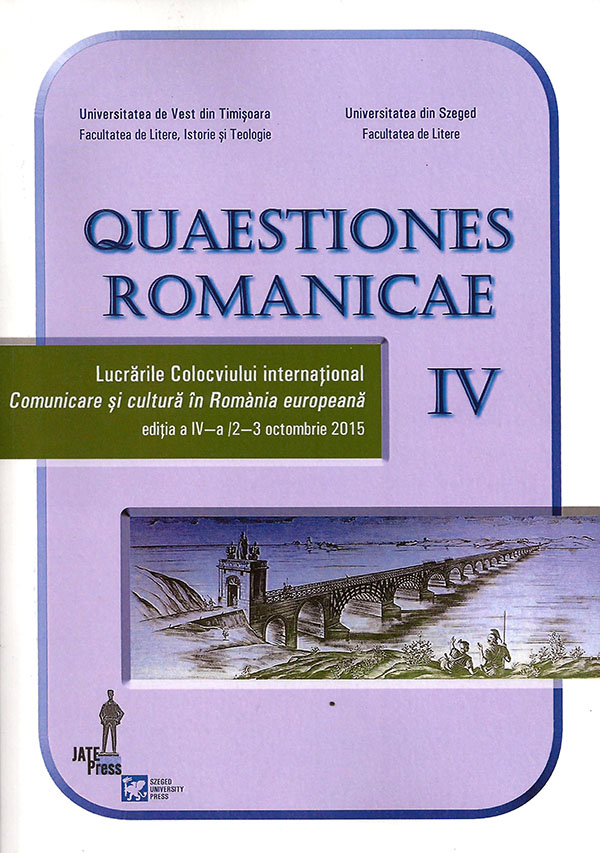Pagini de estetică și de autointerpretare: Fernando Pessoa, abstractorul
Abstract: (Pages of aesthetics and self-interpretation: Fernando Pessoa, the abstractor). In various writings named by editors „Páginas intimas e de auto-interpretação” Fernando Pessoa tried to define two essential concepts in his creation: „static drama” and „drama em gente”. Many of his critics think these concepts are interrelated as to become the spectacle of Pessoa’s heteronomy per se. This was initiated, most probably, with the publishing of „O Marinheiro”. This paper looks into the explanations Pessoa himself presented about the dramatic poem, the poetic prose, and particularly about the static drama. The contradictions are easily visible, but in Pessoa ́s case they are intentional, because he constitues himself as a multiple of himself. It is interesting to observe that every time, Pessoa starts with an already canonized genre, which he modifies and turns abstract. The same happens with the symbolist drama, from which he only borrows a certain attitude, rejecting the action and the individualization of the characters, and focusing on the „soul revolution” of the symbolic characters. The same happens in parabolas such as „O Eremita da Serra Negra” or „A Morte do Príncipe”; where he brings together different references from the world literature, even if every time his text establishes unique linkages with older themes of his heteronymic family, that do not exist in the models taken as reference. Pessoa acknowledges his indebtedness towards the symbolists, this to explain how he modifies certain references. For example, excluding from the symbolist drama what he considered to be too carnal or too circumstantial, with the scope of finding the tone, and even the static character of the ancient drama.
Keywords: „static drama”, „drama em gente”, inspirations and references, heteronimy, Fernando Pessoa.
Rezumat: În numeroase scrieri grupate de editori sub titlul generic „Pagini de estetică și de autointerpretare”, Fernando Pessoa a încercat să definească două concepte esentiale pentru opera lui: „drama statică” si „drama em gente”. Multi comentatori cred că ele sunt corelate pentru a deveni chiar spectacolul heteronimiei lui Pessoa începând, probabil, din momentul în care a fost conceput iar apoi publicat Marinarul. Comunicarea de fată face o scurtă trecere în revistă a principalelor explicatii date de însusi Pessoa despre poemul dramatic, sau despre proza poematică, si în principal despre drama statică. Contradictile ies repede la iveală, dar în cazul lui Pessoa sunt discrepanțe intenționate, căci el se construiește ca un multiplu al lui însuși. Interesant este să observăm că de fiecare dată Pessoa pornește de la un gen deja canonizat, pe care îl modifică și îl abstractizează. Este cazul dramei simboliste, de la care el preia numai o anumită atitudine, adică respinge actiunea și individualizarea personajelor, pentru a pune accentul pe „revoluția de suflet” a personajelor simbolice. Dar este și cazul unor parabole precum „Schivnicul din muntele cel negru”, sau „Moartea Principelui”, unde confluează diverse surse din literatura lumii, deși de fiecare dată textul lui Pessoa stabileste corelatii inedite cu mai vechi teme ale familiei sale heteronimice, ce nu există în modelele luate ca referintă. Pessoa îsi recunoaste datoriile fată de simbolisti, pentru a spune însă cum îsi modifică el anumite surse. De exemplu, eliminind din drama simbolistă ceea ce i se părea prea carnal sau prea circumstantial, pentru a găsi tonul, si chiar caracterul static, al dramei antice.
Cuvinte cheie: „drama statică”, „drama em gente”, insiprații și surse, heteronimie, Fernando Pessoa.
